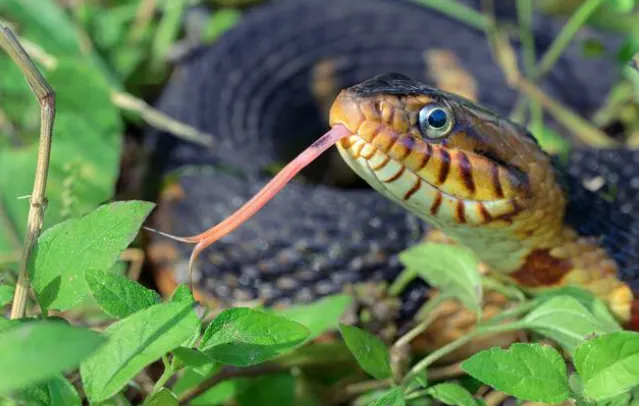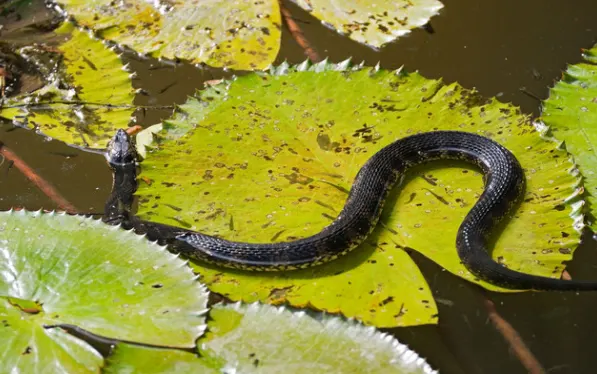The Banded Water Snake, scientifically known as Nerodia fasciata, is a non-venomous, medium-sized snake commonly found in the southeastern United States. Recognizable by its distinctive bands and semi-aquatic lifestyle, this snake plays a crucial role in its ecosystem by controlling populations of its prey. This blog post will cover everything you need to know about the Banded Water Snake, from its physical characteristics and habitat to its behavior and conservation status.
Table of Contents
Scientific Classification
- Kingdom: Animalia
- Phylum: Chordata
- Class: Reptilia
- Order: Squamata
- Family: Colubridae
- Genus: Nerodia
- Scientific Name: Nerodia fasciata

Physical Characteristics
Banded Water Snakes are notable for their heavy bodies and variable coloration, which can range from brown and grey to red and olive. They typically grow between two to five feet in length. One of the key identifying features is the vertical bars around their lip scales. These snakes have a lifespan of about three years in captivity and up to eight years in the wild.
Habitat and Distribution
These snakes are primarily found along the Coastal Plain from North Carolina to Southwest Alabama, and they also inhabit parts of Florida, Texas, and Arizona. Banded Water Snakes prefer vegetated ponds, lakes, ditches, streams, rivers, swamps, wetlands, and marshes. They are often seen basking on logs and branches near water bodies and foraging in shallow waters for their prey.
Behavior and Temperament
Banded Water Snakes are solitary creatures except during mating season. They are known for their aggressive defense mechanisms when threatened, including flattening their bodies, emitting a foul smell from their anal glands, and biting repeatedly. Despite their aggressive defense, they are non-venomous and pose little threat to humans.
Diet
These snakes are omnivores, primarily preying on frogs, fish, and small birds. Their diet helps control the populations of these animals, making them an essential part of their ecosystem.
Reproduction
Banded Water Snakes give birth to live young, with litter sizes ranging from 8 to 40. The young are born fully independent and exhibit the same aggressive behaviors as adults when threatened.
Conservation Status
The Banded Water Snake is currently listed as “Least Concern” on the IUCN Red List. This classification indicates that the species is widespread and abundant, with no major threats impacting its population. However, in some states like Georgia, they are protected by law.
Evolution and Origins
The earliest known snake fossils date back to the Jurassic period, approximately 143 to 167 million years ago. Snakes are believed to have evolved from either burrowing or aquatic lizards. The Banded Water Snake, like many other water snakes, enjoys a variety of freshwater environments and has adapted well to its semi-aquatic lifestyle.
Types of Banded Water Snakes
There are three subspecies of the Banded Water Snake:
- Southern Water Snake (Nerodia fasciata fasciata)
- Broad-Banded Water Snake (Nerodia fasciata confluens)
- Florida Water Snake (Nerodia fasciata pictiventris)
These subspecies are primarily distinguished by their geographic distribution.
Population and Conservation
The Banded Water Snake is abundant and widespread across its range. The primary threats to this species are habitat destruction and human persecution due to misidentification with venomous snakes like the cottonmouth. Despite these threats, their population remains stable, and no significant conservation measures are currently necessary.
Appearance and Identification
Banded Water Snakes are medium-sized, ranging from 24 to 48 inches in length, with a maximum length of five feet. They have a variety of colors, including yellow-tan, grayish-brown, and reddish, with distinctive dark crossbands that are larger in the middle of the back and narrower on the sides. Over time, these crossbands may become obscured as the snake’s coloration darkens.
Venom and Danger
Despite their aggressive defense behaviors, Banded Water Snakes are non-venomous and not dangerous to humans. Their bites, however, can be painful and may tear the skin due to their sharp teeth, which are adapted to holding onto slippery prey.
Behavior Towards Humans
Banded Water Snakes are generally not friendly towards humans and can become aggressive if threatened or handled. They are best observed from a distance in their natural habitat. These snakes are not suitable for captivity and are better left in the wild.

FAQs about Banded Water Snakes
Q: Are Banded Water Snakes venomous?
A: No, Banded Water Snakes are non-venomous. Their bites can be painful but are not dangerous to humans.
Q: How do Banded Water Snakes hunt?
A: They hunt by lying in wait near bodies of water, quickly striking and biting their prey, which includes fish, frogs, and small birds.
Q: Are Banded Water Snakes aggressive?
A: They can be aggressive if they feel threatened. They defend themselves by flattening their bodies, emitting a foul smell, and biting repeatedly.
Q: Where do Banded Water Snakes live?
A: They are found in the southeastern United States, particularly along the Coastal Plain from North Carolina to Alabama, as well as parts of Florida, Texas, and Arizona.
Q: What do Banded Water Snakes eat?
A: Their diet primarily consists of fish, frogs, and small birds.
Q: What is the lifespan of a Banded Water Snake?
A: They live about three years in captivity and up to eight years in the wild.
Q: What is the lifecycle of a Banded Water Snake?
A: They give birth to live young between May and August, with the young reaching maturity between their second and third years.
Q: What are the differences between copperheads and Banded Water Snakes?
A: Copperheads are venomous, while Banded Water Snakes are not. They also differ in coloration and behavior when threatened.
The Banded Water Snake is a fascinating and important species in its ecosystem. By controlling populations of fish, frogs, and small birds, they help maintain a balanced environment. Despite their aggressive defense mechanisms, they are non-venomous and pose little threat to humans. Understanding and respecting these creatures can help reduce unnecessary fear and harm, ensuring they continue to thrive in their natural habitats.
- Enchi Ball Python: A Unique and Stunning Morph of Python regius - March 27, 2025
- Emerald Tree Monitor: The Enigmatic Green Guardian of the Rainforest - March 26, 2025
- The Egyptian Cobra (Naja haje): A Fascinating Serpent - March 25, 2025
